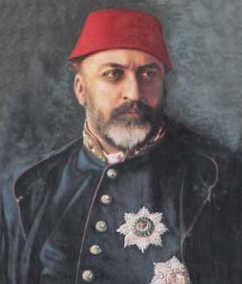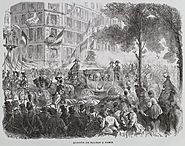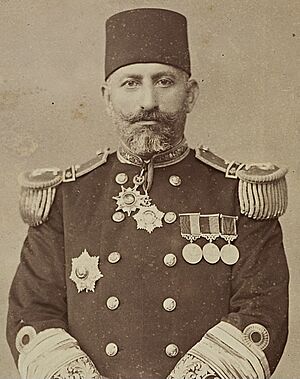Abdulaziz facts for kids
Quick facts for kids Abdulaziz |
|||||
|---|---|---|---|---|---|
| Ottoman Caliph Amir al-Mu'minin Custodian of the Two Holy Mosques Khan |
|||||
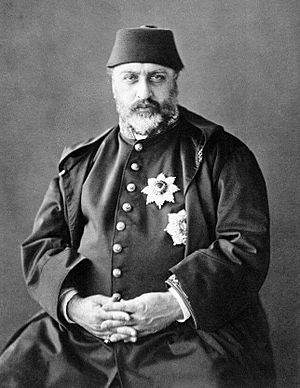
Photo by Abdullah Frères
|
|||||
| Sultan of the Ottoman Empire (Padishah) | |||||
| Reign | 25 June 1861 – 30 May 1876 | ||||
| Predecessor | Abdulmejid I | ||||
| Successor | Murad V | ||||
| Grand viziers |
See list
Mehmed Emin Âli Pasha
Mehmed Fuad Pasha Yusuf Kamil Pasha Mehmed Rushdi Pasha Mahmud Nedim Pasha Midhat Pasha Ahmed Esad Pasha Şirvanlı Mehmed Rüşdi Pasha Hüseyin Avni Pasha |
||||
| Born | 8 February 1830 Constantinople, Ottoman Empire |
||||
| Died | 4 June 1876 (aged 46) Feriye Palace, Constantinople, Ottoman Empire |
||||
| Burial | Tomb of Sultan Mahmud II, Fatih, Istanbul | ||||
| Consorts |
|
||||
| Issue Among others |
|
||||
|
|||||
| Dynasty | Ottoman | ||||
| Father | Mahmud II | ||||
| Mother | Pertevniyal Sultan | ||||
| Religion | Sunni Islam | ||||
| Tughra |  |
||||
Abdulaziz (born February 8, 1830, died June 4, 1876) was the 32nd sultan of the Ottoman Empire. He ruled from June 25, 1861, to May 30, 1876. He became sultan after his brother, Abdulmejid I.
Abdulaziz was born in Constantinople (now Istanbul). He learned about Ottoman traditions but also admired new ideas from the West. He was the first Ottoman sultan to travel to Western Europe. In 1867, he visited major cities like Paris, London, and Vienna.
He loved the Ottoman Navy, which was the world's third largest in 1875. He also enjoyed literature and composed classical music. Some of his musical works are in an album called European Music at the Ottoman Court. He was removed from power in 1876.
Contents
Early Life and Family
Abdulaziz's parents were Mahmud II and Pertevniyal Sultan. His mother, Pertevniyal, was from Circassia. In 1868, the Empress of France, Eugénie de Montijo, visited Pertevniyal at Dolmabahçe Palace.
Pertevniyal felt it was wrong for a foreign woman to be in her private rooms. Some stories say she reacted strongly to the Empress. The Pertevniyal Valide Sultan Mosque was built under his mother's support. Construction started in 1869 and finished in 1871.
Sultan Abdulaziz's Rule


From 1861 to 1871, Abdulaziz continued the Tanzimat reforms. These changes aimed to modernize the Ottoman Empire. His main ministers, Mehmed Fuad Pasha and Mehmed Emin Âli Pasha, led these efforts.
New administrative areas were created in 1864. A Council of State was also set up in 1868. Public education was organized like the French system. Istanbul University was modernized in 1861. Abdulaziz also helped create the first Ottoman civil law code.
Abdulaziz worked to have good relationships with France and the United Kingdom. In 1867, he was the first Ottoman sultan to visit Western Europe. He went to the Exposition Universelle (1867) in Paris.
He also visited the United Kingdom. There, Queen Victoria made him a Knight of the Garter. He saw a large Royal Navy Fleet Review. He traveled in a special train car, which is now in the Rahmi M. Koç Museum in Istanbul.
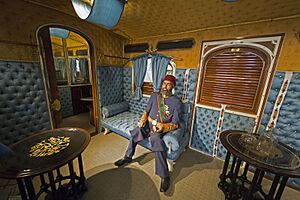

In 1867, Abdulaziz officially recognized the title of Khedive for the governor of Ottoman Egypt and Sudan. This made Egypt and Sudan an autonomous region. In return, Egypt agreed to pay more taxes to the Ottoman treasury.
These tax payments from Egypt and Sudan were used as a guarantee for loans from British and French banks. The Suez Canal, which opened in 1869, also became very important. These factors led to Britain's decision to occupy Egypt and Sudan in 1882.
In 1869, Abdulaziz welcomed visits from Empress Eugénie of France and other foreign leaders. They were on their way to the opening of the Suez Canal. The Prince of Wales, who later became Edward VII, also visited Istanbul twice.
By 1871, his key ministers, Mehmed Fuad Pasha and Mehmed Emin Âli Pasha, had passed away. The Second French Empire, which he admired, was defeated in a war. Abdulaziz then sought friendship with the Russian Empire.
However, problems continued in the Balkan provinces. In 1875, the Herzegovinian rebellion began. In 1876, the April Uprising spread among the Bulgarians. People became unhappy with Russia for encouraging these rebellions.
Several issues led to Abdulaziz being removed from power. A bad harvest in 1873 and his high spending on the Ottoman Navy and new palaces caused financial problems. The growing public debt also contributed to the unrest. Abdulaziz was removed from power by his ministers on May 30, 1876.
Death
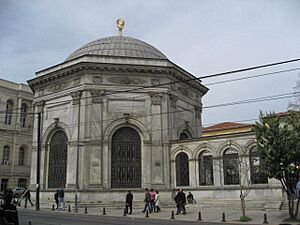
Abdulaziz passed away at Çırağan Palace in Istanbul a few days after being removed from power.
After he was dethroned, he was moved to a room at Topkapi Palace. This was the same room where Sultan Selim III had been murdered. Abdulaziz became worried for his safety. He asked to be moved to Beylerbeyi Palace, but this was not allowed. He was moved to Feriye Palace instead.
He grew increasingly nervous about his safety. On the morning of June 5, he asked for scissors to trim his beard. Shortly after, he was found dead.

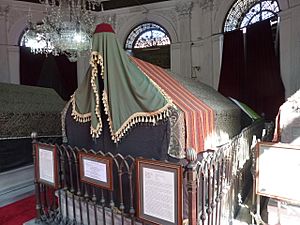
What Abdulaziz Achieved

- Abdulaziz focused on making the Ottoman Navy modern. By 1875, the Ottoman Navy had 21 battleships and 173 other warships. This made it the third largest navy in the world. His love for the navy can be seen in the paintings at Beylerbeyi Palace. However, the high cost of the navy, along with droughts and floods, led to financial problems. This caused the Ottoman government to declare it could not pay its foreign debts in 1875. This led to more problems in the empire.
- The first Ottoman railroads opened in 1856. But these were separate lines. Sultan Abdulaziz started building the first railway networks. In 1869, a railway project was approved to connect Istanbul to Vienna. The first Sirkeci Terminal in Istanbul opened in 1873. He also started the Anatolia Railway in 1871. This railway later extended to Ankara and beyond.
- Under his rule, Turkey's first postage stamps were issued in 1863. The Ottoman Empire also joined the Universal Postal Union in 1875.
- He was also responsible for creating the first civil code for the Ottoman Empire. This was a set of laws for everyday life.
- He was the first Ottoman sultan to travel to Western Europe. His trip in 1867 included visits to Paris, London, Brussels, Koblenz, and Vienna.
- He was impressed by the museums he visited in Europe. Because of this, he ordered the creation of an Imperial Museum in Istanbul. This museum is now the Istanbul Archaeology Museum.
Family
Abdulaziz had several consorts and many children. His mother, Pertevniyal Sultan, continued to send slave girls from the Caucasus to his harem, even though slavery was officially abolished.
Consorts
Abdulaziz had six main consorts:
- Dürrinev Kadın (1835-1895). She was Georgian and had two sons and one daughter.
- Edadil Kadın (1845-1875). She was Abkhazian and had one son and one daughter.
- Hayranidil Kadın (1846-1895). She had one son and one daughter.
- Neşerek Kadın (1848-1876). She was Circassian and had one son and one daughter.
- Gevheri Kadın (1856-1884). She was Abkhazian and had one son and one daughter.
- Yıldız Hanim. She had two daughters.
Abdulaziz had planned to marry an Egyptian princess, Tawhida Hanim. However, this marriage did not happen due to political reasons.
Sons
Abdulaziz had six sons:
- Şehzade Yusuf Izzeddin (1857-1916). He was his father's favorite son. Abdulaziz tried to change the law so Yusuf Izzeddin could inherit the throne.
- Şehzade Mahmud Celaleddin (1862-1888). He was a vice admiral, pianist, and flutist.
- Şehzade Mehmed Selim (1866-1867). He died as a baby.
- Abdulmejid II (1868-1944). He never became sultan because the Sultanate was abolished in 1922. He was the last caliph of the Ottoman Empire.
- Şehzade Mehmed Şevket (1872-1899). He was raised by Abdulhamid II after his parents passed away.
- Şehzade Mehmed Seyfeddin (1874-1927). He was also a vice admiral and musician.
Daughters
Abdulaziz had seven daughters:
- Fatma Saliha Sultan (1862-1941). She had one daughter.
- Nazime Sultan (1866-1947). She did not have any children.
- Emine Sultan (1866-1867). She died as a baby.
- Esma Sultan (1873-1899). She had four sons and one daughter. She passed away during childbirth.
- Fatma Sultan (1874-1875). She died as a baby.
- Emine Sultan (1874-1920). She had one daughter.
- Münire Sultan (1876-1877). She was born after her father's death and died as a newborn.
Honours
 Mexican Empire: Grand Cross of the Mexican Eagle, 1865
Mexican Empire: Grand Cross of the Mexican Eagle, 1865 United Kingdom: Stranger Knight of the Garter, August 14, 1867
United Kingdom: Stranger Knight of the Garter, August 14, 1867 Kingdom of Portugal: Grand Cross of the Tower and Sword
Kingdom of Portugal: Grand Cross of the Tower and Sword Spain: Knight of the Golden Fleece, June 24, 1870
Spain: Knight of the Golden Fleece, June 24, 1870 Oldenburg: Grand Cross of the Order of Duke Peter Friedrich Ludwig, December 14, 1874
Oldenburg: Grand Cross of the Order of Duke Peter Friedrich Ludwig, December 14, 1874
Images for kids
See also
 In Spanish: Abdülaziz I para niños
In Spanish: Abdülaziz I para niños


